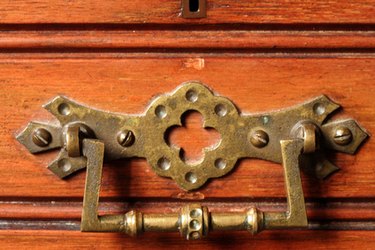
An alloy is a combination of two or more metals; brass is an alloy made up of about 70% copper and 30% zinc. Brass can be made into solid shapes by casting them in molds or it can be rolled into thin sheets or spun to make wire or vessel shapes. In your home you may have decorative objects, furniture or other housewares made of brass. Brass is also found in scientific instruments, scale models and historical objects.
1. Oxidation of Copper
Video of the Day
Safe corrosion will look reddish, black to brown or green to blue. Safe corrosion will occur if the brass has been kept clean and dry. If it is brownish or black this will be due to oxidization of the copper which occurs when exposed to air; this a natural phenomenon and is non-destructive. This is usually called "tarnish" and can be removed by careful cleaning and polishing. If the corrosion is green, continuous and non-flaky this again is safe corrosion.
Video of the Day
2. Salts or Cleaning Products
Active corrosion can be seen if there are spots of green powder that are spreading rapidly on the object, this is called "bronze disease" and is active corrosion. Bright or waxy whitish green spots are also signs of active corrosion; this is caused by salts in the air or by cleaning products or inappropriate handling of the object. Both of these conditions in brass will be heightened by high humidity; dust and grime can thus cause active corrosion as they will hold moisture onto the surface of the brass. High levels of ammonia can also cause corrosion; this will result in bluish deposits on the brass.
3. Denting or Abrasions
Objects that are delicate or have fine detailing can be easily damaged by rough handling, which causes abrasions or denting in the brass. Discoloration and possibly active corrosion will occur if dirt, moisture or cleaning products get into tiny cracks or abrasions in the brass. Careful handling and cleaning are essential for delicate brass objects.
Keep Your Brass Clean
Keep your brass objects dust-free -- use the nozzle on your vacuum cleaner to remove dust on stable objects, and use a toothbrush on small, finer pieces. You can use soap and water for cleaning brass, but when wet cleaning ensure that you use distilled or deionized water, and that you rinse the brass thoroughly removing any residue and soap. Use mineral spirits to remove grease and grime, using bamboo skewers or a toothbrush to get into small crevices. If brass is corroded, it should be cleaned by a trained conservator. Before polishing brass it is better to check with a conservator if the brass has a special surface or finish and ask about the best way to polish the brass.